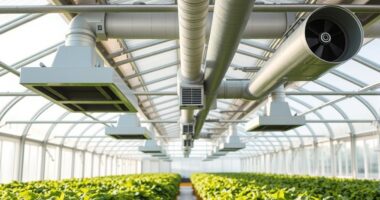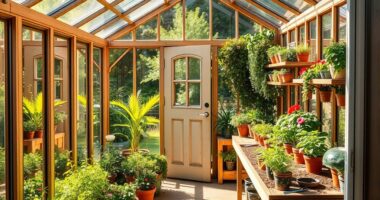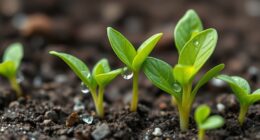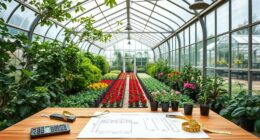To build a successful greenhouse, you’ll need essential tools like drills, measuring tapes, and safety glasses for accurate assembly. Key materials include lightweight aluminum, impact-resistant polycarbonate, and treated lumber for durability. Don’t overlook foundation options like concrete or gravel for stability. Proper glazing materials will enhance light transmission for your plants. Exploring ventilation and cooling systems is vital for ideal growth. Keep going to discover more about ensuring your greenhouse thrives!
Key Takeaways
- Essential construction tools include a drill, measuring tape, hammer, level, and safety gear for safe and accurate assembly.
- Aluminum frames are lightweight and rust-resistant, making them ideal for greenhouse structures.
- Polycarbonate panels provide impact resistance and energy efficiency for optimal plant growth conditions.
- Concrete foundations offer durability, while wooden bases enhance drainage and aesthetic appeal.
- Additional features like drip irrigation and ventilation systems improve functionality and environmental management in the greenhouse.
Blueprints and Sketches
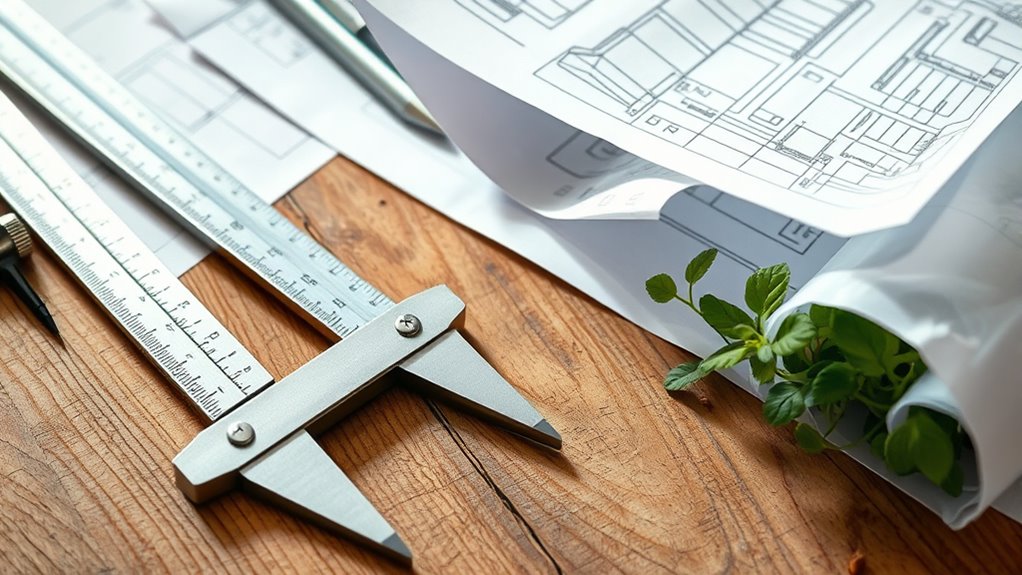
Blueprints and sketches are the backbone of successful greenhouse construction. They guarantee accuracy in measurements and material lists, helping you minimize waste and optimize costs.
Using software tools like SketchUp or AutoCAD allows you to create detailed designs, while freehand sketches can effectively convey simple ideas.
Don’t overlook the importance of ventilation planning and space utilization; these factors are essential for plant growth. Scale models can help visualize your greenhouse, while online resources offer free plans complete with materials lists and step-by-step instructions.
Whether you’re customizing a design or following a template, detailed blueprints will keep your project compliant with local regulations and guarantee structural integrity, setting you up for success.
Essential Construction Tools

Once you have your blueprints ready, it’s time to gather the right tools for constructing your greenhouse. First, you’ll need a drill for fastening components together.
Don’t forget your safety glasses and work gloves to protect yourself during the build. Knee pads will come in handy for those times you’re working on the ground. A measuring tape is essential for ensuring accurate dimensions throughout the construction process.
In addition to these basics, consider having a hammer, level, and square on hand for proper framing and assembly.
Finally, make sure you’ve got a utility knife for cutting materials to size. With these essential construction tools, you’ll be well-prepared to bring your greenhouse vision to life.
Key Construction Materials
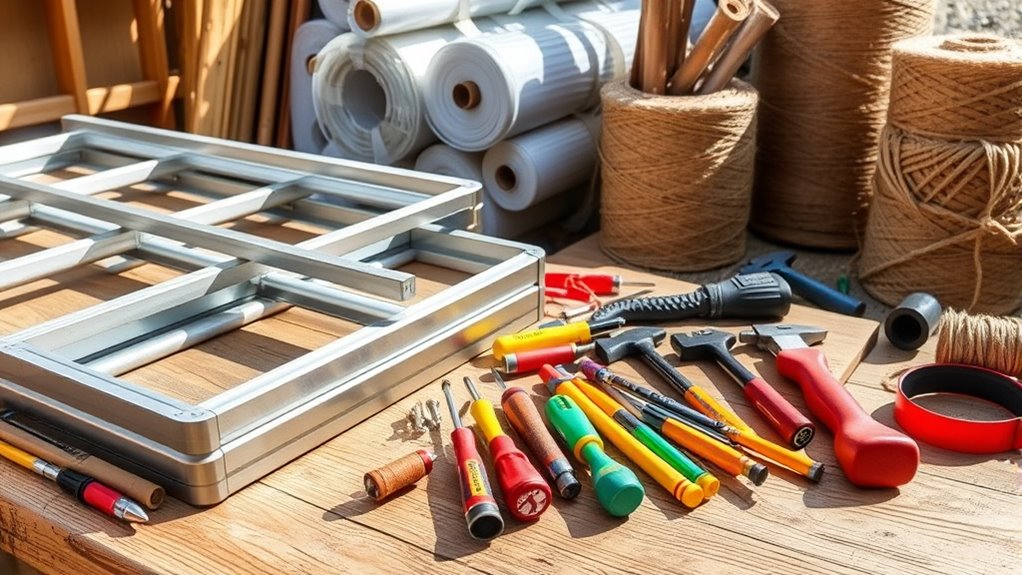
Choosing the right construction materials is essential for building a successful greenhouse.
You’ll want to take into account durability, insulation, and maintenance when selecting materials. Here are some key options:
- Aluminum: Lightweight and rust-resistant, great for various greenhouse sizes.
- Polycarbonate Panels: Impact-resistant and energy-efficient, perfect for insulation.
- Treated Lumber: Ideal for smaller frames, offering decay resistance.
These materials will help create a sturdy structure that can withstand the elements while providing a suitable environment for your plants.
Foundation and Base Materials
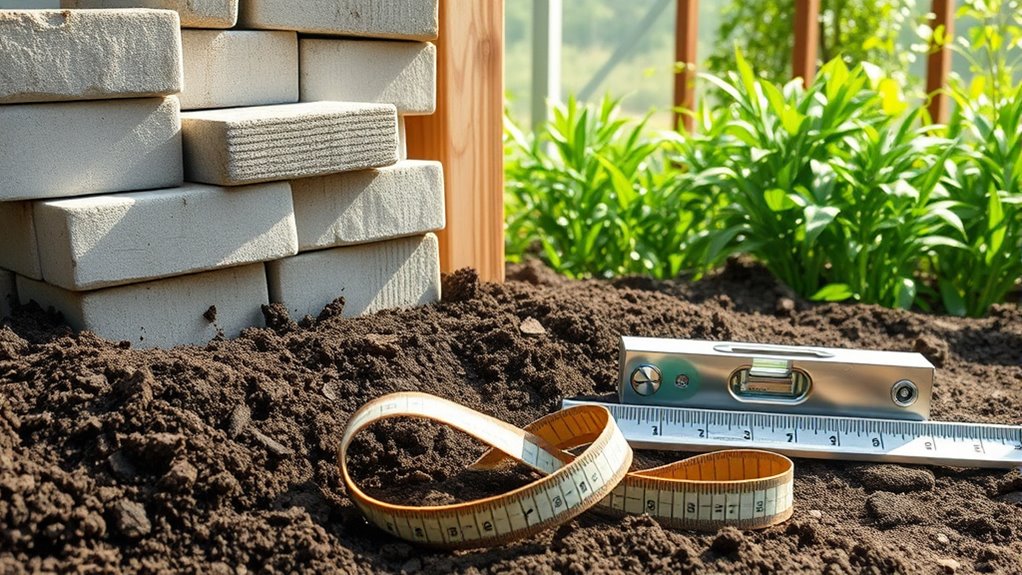
When building your greenhouse, choosing the right foundation and base materials is vital for its stability and longevity.
You can opt for concrete for durability, wooden bases for better drainage, or gravel for a cost-effective solution.
Each option has its pros and cons, so it’s important to take into account your specific needs and local conditions.
Types of Foundations
Selecting the right foundation type for your greenhouse is essential for ensuring stability and longevity. Various options cater to different needs, climates, and budgets.
Here are three popular foundation types to evaluate:
- Concrete Slab: Durable and long-lasting, perfect for permanent structures.
- Wooden Perimeter: Aesthetically pleasing and easy to build, great for backyard setups.
- Raised Perimeter: Enhances drainage and adds height, benefitting plant growth.
Before deciding, assess your site for slope, soil, and drainage issues.
Keep local permit requirements in mind, as some foundations may need approval.
Ultimately, choosing the right foundation will set the stage for a successful greenhouse that withstands the test of time and weather.
Base Material Options
After establishing a solid foundation for your greenhouse, the next step is to assess the base materials that will support your structure. Here are some options to take into account:
| Base Material | Characteristics |
|---|---|
| Concrete | Durable and long-lasting |
| Wood | Affordable and aesthetic |
| Paving Slabs | Creates a level surface |
| Gravel/Crushed Stone | Improves drainage and stability |
| Metal Bases | Easy to install, weather-resistant |
Each material has its pros and cons regarding durability, drainage, and cost. Concrete is sturdy but can impact temperature, while wood requires treatment against rot. Choose wisely based on your greenhouse’s needs, climate, and budget to guarantee longevity and effectiveness.
Glazing and Covering Materials
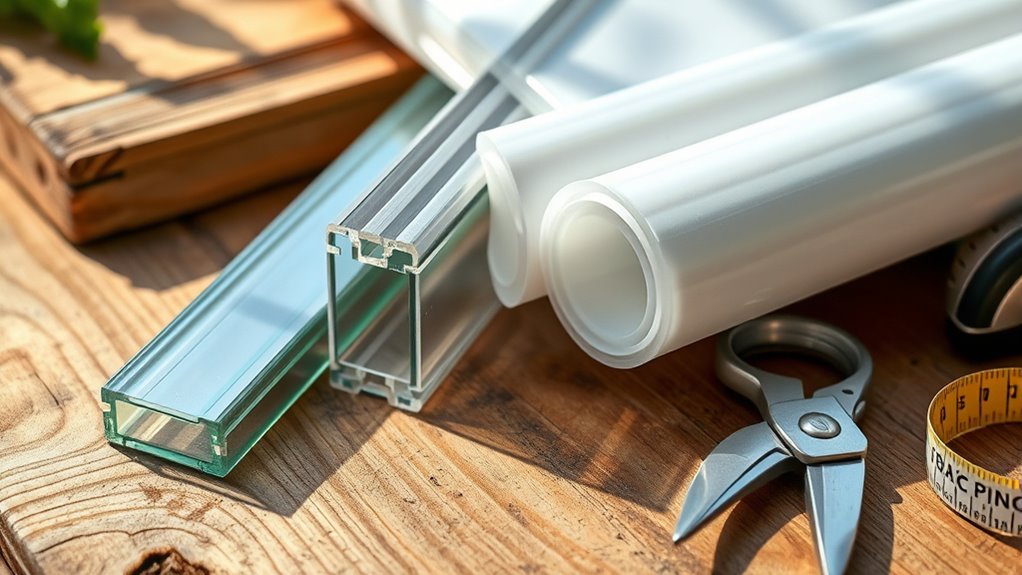
When it comes to glazing and covering materials for your greenhouse, you’ll find several options that cater to different needs.
Polycarbonate panels are popular for their lightweight and impact-resistant properties, while traditional glass offers unmatched light transmission.
Understanding the benefits and drawbacks of each choice can help you create the ideal environment for your plants.
Types of Glazing Materials
There are several types of glazing materials you can choose from for your greenhouse, each with its own advantages and drawbacks.
Here are some popular options:
- Glass: Excellent light transmission and longevity but heavy and costly.
- Polyethylene Film: Affordable and lightweight, though it lacks insulation.
- Acrylic: High light transmission and durability, yet can be pricey.
When selecting your glazing material, consider factors like installation ease, durability, and insulation properties. Creating your perfect backyard greenhouse can help you understand the best options for your specific needs.
Glass provides the best light, while polyethylene is budget-friendly.
Each option has its unique benefits, so align your choice with your greenhouse goals for ideal growing conditions.
Benefits of Polycarbonate Panels
While considering glazing options for your greenhouse, polycarbonate panels stand out for their numerous benefits.
They’re 200 times stronger than glass, providing exceptional durability against impacts from hail and wind. With excellent thermal insulation, these panels help retain warmth, reducing your heating costs. This durability and efficiency can lead to a greater sense of emotional well-being as you cultivate your plants in a secure environment.
Plus, they transmit up to 92% of light, promoting ideal plant growth. You’ll appreciate the UV protection they offer, filtering harmful rays while allowing beneficial ones to pass through.
Their flexibility enables custom designs, and they require less maintenance than glass—just a clean once or twice a year. Incorporating backyard greenhouses into your gardening plans can further enhance your ability to grow food year-round.
Glass vs. Plastic Options
Which glazing material should you choose for your greenhouse: glass or plastic?
Both options have their pros and cons, so let’s break it down:
- Light Transmission: Glass provides superior light transmission, perfect for sun-loving plants.
- Cost-Effectiveness: Plastic is generally cheaper and easier to install, making it budget-friendly.
- Durability: Glass is more durable but heavier; plastic is lighter and impact-resistant.
If you prioritize light and durability, glass might be your go-to.
On the other hand, if you’re looking for affordability, ease of installation, and safety, plastic could be the better choice.
Consider your specific greenhouse needs and climate conditions before making your final decision.
Ventilation and Cooling Systems

To guarantee healthy plant growth in your greenhouse, effective ventilation and cooling systems are vital. These systems maintain airflow and regulate temperature, preventing humidity buildup that can harm your plants.
You’ll find components like fans, vents, and shutters in most ventilation packages, often equipped with thermostats for automated operation.
For cooling, consider evaporative cooling methods, such as pad and fan systems, which are energy-efficient and effective in hot, dry climates. Alternatively, mechanical cooling systems can also be used.
Both methods help manage temperature and humidity, important for preventing diseases and promoting healthy growth. By investing in the right ventilation and cooling solutions, you’ll secure a favorable environment for your plants to thrive.
Additional Equipment and Features
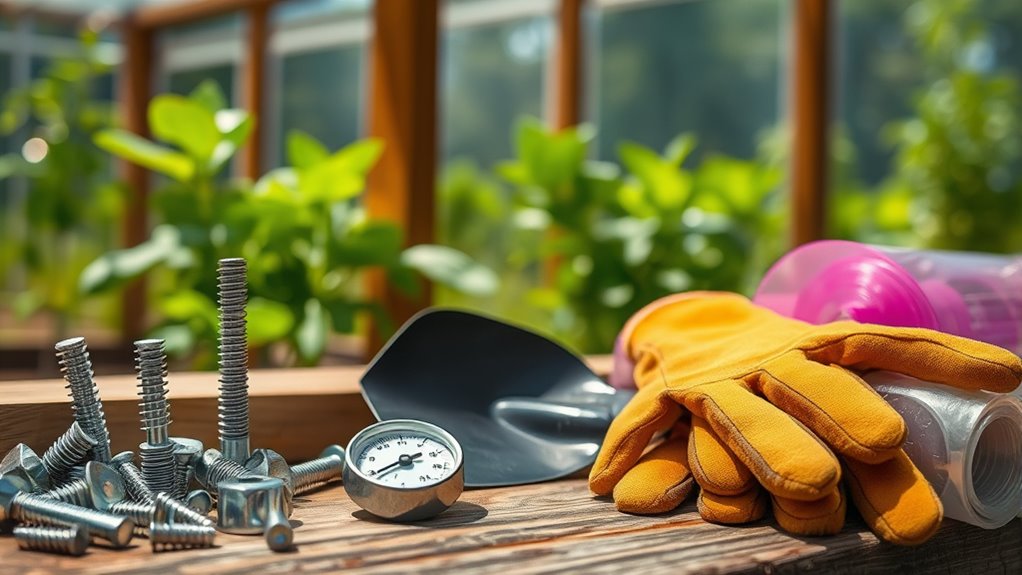
Effective ventilation and cooling systems lay the groundwork for a thriving greenhouse, but they’re just part of the picture.
Effective ventilation and cooling systems are essential for a successful greenhouse, setting the stage for plant growth.
To maximize your greenhouse’s efficiency, consider adding essential equipment and features that enhance functionality and organization. Here are a few must-haves:
- Potting Bench: A dedicated workspace for potting and planting boosts your efficiency.
- Drip Irrigation System: Automate watering for consistent moisture levels, promoting healthy growth.
- Temperature and Humidity Sensors: Monitor environmental conditions to optimize plant health.
These additions not only streamline your gardening tasks but also create an environment where your plants can flourish.
Compliance With Local Building Codes
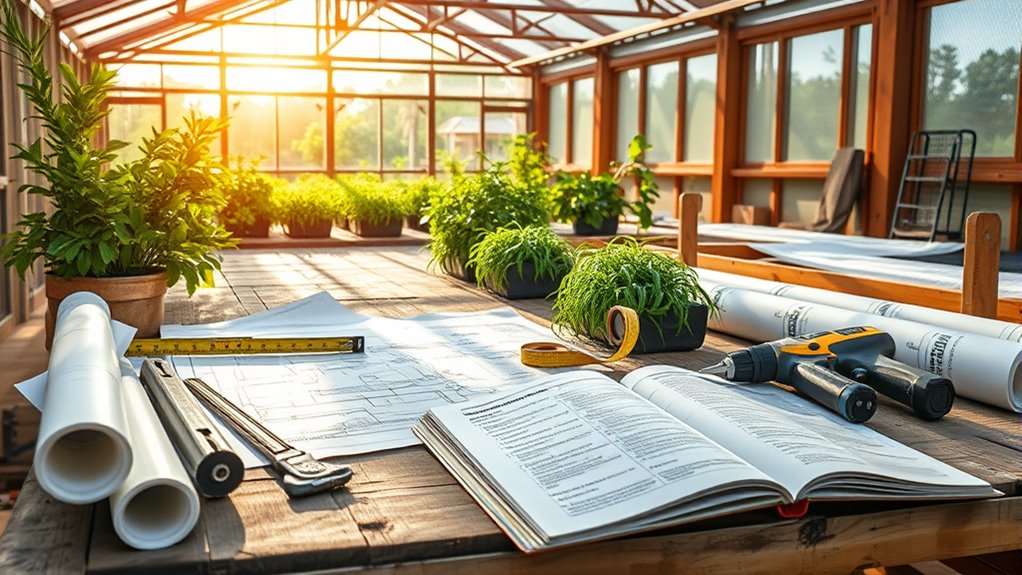
Maneuvering through local building codes is essential for anyone planning to construct a greenhouse, as these regulations guarantee safety and compliance while optimizing your project.
Building codes dictate the size, type of structure, and materials allowed, ensuring your greenhouse meets specific standards. Compliance is vital to avoid penalties and enhances structural integrity.
Remember, mechanically heated or cooled greenhouses may be exempt from certain requirements, but they still need to adhere to thermal envelope standards.
Local regulations often influence design choices and costs, so it’s smart to consult with local officials early on. By doing this, you’ll not only comply with the law but also boost your greenhouse’s value and longevity.
Regular inspections can help keep your project on track.
Frequently Asked Questions
How Do I Choose the Right Location for My Greenhouse?
To choose the right location for your greenhouse, start by evaluating sun exposure and accessibility.
Make certain it’s near water and electricity sources for efficient operation.
Consider environmental factors like wind protection and drainage, as these influence plant health.
Look for a level area with minimal shade and a suitable microclimate.
Finally, check local regulations to avoid any legal issues.
Planning for future needs, like expansion space, will also benefit you down the line.
What Is the Average Cost of Building a Greenhouse?
The average cost to build a greenhouse is around $9,640, but you might find prices ranging from $3,071 to $16,209.
If you opt for a professional build, expect to spend about $11,000 on average. Costs vary based on size, materials, and added features like electricity or plumbing.
DIY options can save you money, but they require more time and effort. Ultimately, your choices will shape the final price tag.
How Long Does It Typically Take to Construct a Greenhouse?
It typically takes you several weeks to a few months to construct a greenhouse, depending on its size and complexity.
Smaller DIY projects can be finished in a weekend, while medium-sized ones usually require more time.
If you’re hiring professionals, expect a longer timeline due to planning and labor.
Weather conditions and your experience level also play significant roles in how quickly you can complete the project.
Planning well can help speed up the process.
Can I Build a Greenhouse Without Professional Help?
Can you really create your own greenhouse without hiring professionals? Absolutely!
With some planning, determination, and basic tools, you can build a greenhouse that meets your gardening goals.
You’ll need to measure your space, choose the right materials, and follow a clear design.
While it may take some effort and patience, the satisfaction of nurturing your plants in a space you’ve crafted is worth it.
What Are Common Mistakes to Avoid in Greenhouse Construction?
When constructing a greenhouse, avoid common mistakes like inadequate planning and poor location choice.
Make certain you check local regulations to prevent fines and choose quality materials to guarantee longevity.
Don’t forget about adequate ventilation and temperature control, as these are vital for plant health.
Finally, always plan for future expansions; you’ll want your greenhouse to grow with your needs.
Proper planning now saves you time and money later!
Conclusion
Building your greenhouse is like planting a seed—careful preparation and the right tools will nurture your vision into reality. By gathering essential materials and adhering to local building codes, you lay a strong foundation for growth. Just as sunlight fuels your plants, the right ventilation and cooling systems will cultivate a thriving environment. Embrace this journey, and soon your greenhouse will flourish, symbolizing not just a structure, but the blossoming of your passion for gardening.



